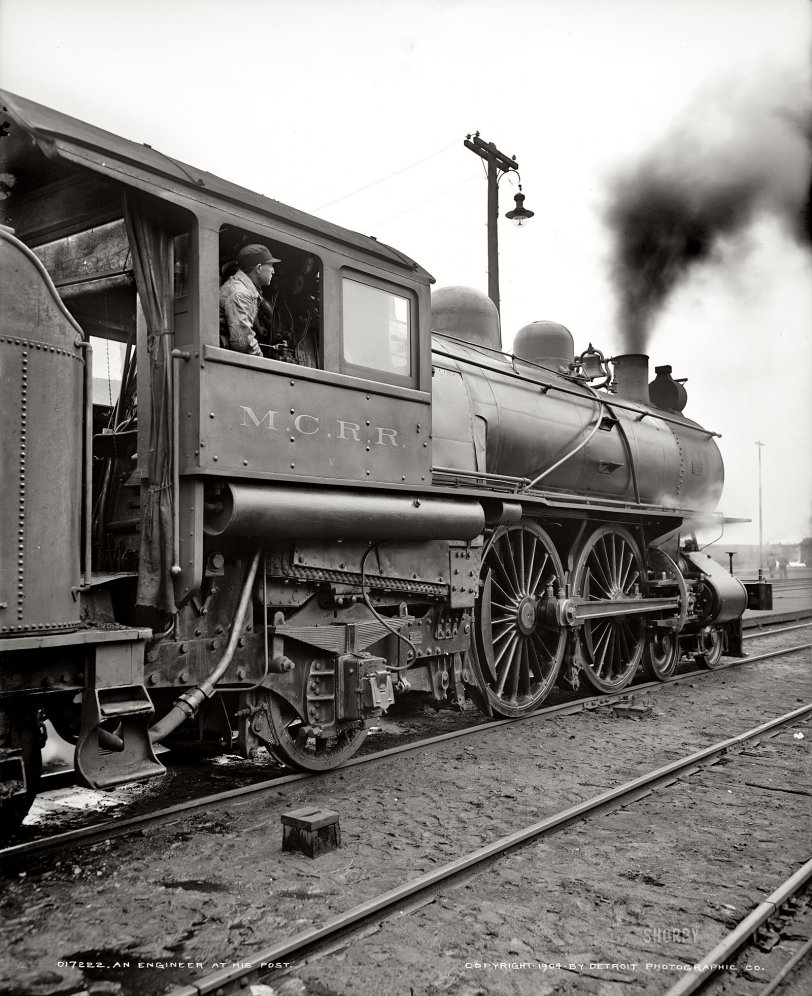


Framed or unframed, desk size to sofa size, printed by us in Arizona and Alabama since 2007. Explore now.
Shorpy is funded by you. Patreon contributors get an ad-free experience.
Learn more.

- Lost in Toyland
- And without gloves
- If I were a blindfolded time traveler
- Smoke Consumer Also Cooks
- Oh that stove!
- Possibly still there?
- What?!?
- $100 Reward
- Freeze Frame
- Texas Flyer wanted
- Just a Year Too Soon
- WWII -- Replacing men with women at the railroad crossing.
- Yes, Icing
- You kids drive me nuts!
- NOT An Easy Job
- I wonder
- Just add window boxes
- Icing Platform?
- Indiana Harbor Belt abides
- Freezing haze
- Corrections (for those who care)
- C&NW at Nelson
- Fallen Flags
- A dangerous job made worse
- Water Stop
- Passenger trains have right of way over freights?
- Coal
- Never ceases to amaze me.
- Still chuggin' (in model form)
- Great shot
Print Emporium
Michigan Central: 1904

Circa 1904. "An engineer at his post, Michigan Central R.R." 8x10 inch dry plate glass negative, Detroit Publishing Company. View full size.
I do declare
Some of these train descriptions read like excerpts from romance novels. Perhaps we're missing out on more than we thought in this day of modern trains!
Now excuse me while I find my fan ...
A good period for steam locomotive aesthetics.
This well groomed locomotive is devoid of several things that mark its place in the history of industrial design, and railroad practice. This locomotive is numbered and not named. It was probably kept in a pool of passenger locomotives, and not assigned to a particular engineer. There are no antlers, enameled filligree, or other ornament to detract from its clean lines. There is also no electric lights, the kerosene headlight will soon give way to an electic one, with electricity supplied by a small steam propelled turbo generator, usually placed just ahead of the cab. These Atlantics would have been premier passenger power then, but soon these would give way to heavier Pacific type 4-6-2s, to better handle the new all steel passenger cars.
The smell...
There is nothing to compare the smell of the old trains and stations. Creosote, coal, oil, steam... To me, it embodied the smell of travel. The closest I can get to the smell is a visit to the Science and Technology Museum to see the train room.
When I worked there, my favourite job was dusting the locomotives (I worked in Conservation and every morning, we dusted before the museum opened). It took me back to travelling by steam train up to Wakefield, Quebec where I was born or down to Kemptville from Ottawa; or the trip to Scotland where we travelled by train.
The old steam train still runs up to Wakefield, it's a tourist special but it still runs down the main street, feet from the road. Sitting in the Blacksheep Inn seeing and hearing the train as it passes by the windows simply can't be beat!
The Thrill of Steam
19th century steam technology wore its power on its sleeve, so to speak. The locomotive engineer presided over a roaring fire in the heavily riveted firebox beneath and in front of the cab, whose superheated gases passed up and forward through the boiler tubes, raising steam which was further superheated in the domes above the boiler before doing its work in the cylinders connected to the drive wheels. Unlike a steamship, with plenty of room to spread out, all this power must be concentrated in a motive unit fitting within the standard dimensions of a train and tracks. Contemplate the arrays of bolts, rivets and massive steel members required to channel this power and withstand the pounding of years of service. No wonder the engineer, riding this beast in exposed conditions, controlling this power (and the whistle) to make the train run on time, was the envy of every boy watching him work.
Great Shot!
This is a priceless photo of an era when the country ran on timetables, train orders and synchronized pocket watches. No computers here, the high rolling 4-4-2 looks set to go with the air line fully charged. Highball!
Pulsating Beast
As a boy I had the pleasure of occasionally traveling by train, most often to go to the country to visit my grandmother. The most memorable part of train travel was walking past the steam engine. It was like a huge living and pulsating beast, radiating heat and making all kinds of sounds -- now considered low tech, but one of man's finest creations.
Do The Locomotion
C'mon baby, do the locomotion!
I was born too late. I would have loved to control one of these babies back during their heyday. I've loved steam engines, and the old cars since I was a young boy.
Atlantic type
This is a so-called "Atlantic" type locomotive with a 4-4-2 wheel arrangement, used almost exclusively in passenger service. Plenty fast, but as the railroads moved away from wooden cars and began utilizing all-steel passenger cars, larger and more powerful locomotives were needed to pull them, and the Atlantic type was essentially obsolete by the 1920s. I believe this example was built by American Locomotive in 1902. The Michigan Central was a longtime subsidiary of the New York Central.
























On Shorpy:
Today’s Top 5